There is the matter of Russian Matryoshka dolls (the wooden nesting dolls, with one inside the other, and the other, etc.). I had no real interest in acquiring any. You can get Polish Babushka dolls (another name for them) in Poland and honestly, if you've been around nesting dolls all your life, they're not that special.
I get a chuckle out of these...
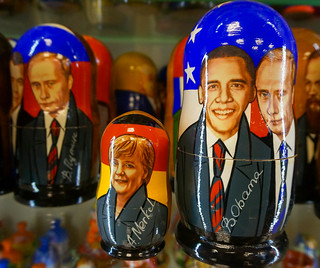
...and I move on. Until I come to Bolshoy Gostiny Dvor. Do you remember two days ago, when I commented on a store that was oddly laid out to be a composite of many stores inside? (Where I bought a Finnish winter hat for Snowdrop?) It turns out that I had stumbled into one segment of the Gostiny Dvor -- which you might think of as one of the world's first indoor shopping malls. The building dates back to the 18th century and if you walk the perimeter of it, you'd cover one kilometer of shops. The segment that abuts the Nevsky Prospect has numerous stores with local artifacts and one such shop had a lovely collection of nesting dolls and a very helpful sales clerk who talks me into purchasing one (or two). These aren't the ones I bought, but they'll give you an idea of how it all looks:
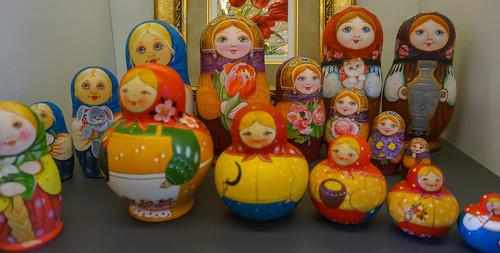
Further down, I almost acquired a beautiful lacquered tray, but that purchase will have to wait. The clerk in that shop had an attitude (so far, she is the only one I have encountered here displaying that harsh indifference to the world and you in it) -- of the type I remember too well from my childhood days of shopping in Polish stores and I scooted out of there quickly so that the memories of those experiences would recede.
My next set of exchanges was entirely of a different nature. Just off of Nevsky Prospect, there is a long, low building housing something called the Art Center. Like the Gostiny Dvor, it has a row of shops on two floors, but here, the vendors sell art. Mostly canvases of their own work, though not only.
I pass through leisurely and I am about to leave, when one of them catches my attention. He is painting a posy of pansies and I contemplate it for a while, wondering if it would look nice on a farmhouse wall. By the time I talk myself out of it, the artist and I have exchanged more than a few sentences. He leads an interesting life, alternating between months here in St. Petersburg and months studying yoga and meditating in the Himalayas. You might say that he is of a reflective disposition.
Eventually I asked about another small canvas in the shop. It was a lovely still life of pears and cherries.
That one is not mine. A friend painted it. Margerita is her name. Here, look at this one -- it's also a still life and the paintings would look good together. You should always have at least two paintings from each artist.
Since I had not intended to buy even one, two seemed especially excessive. Still, I asked: how much?
Oh, for you it is a good price!
I laughed -- I told him the line sounded not too convincing: I'll give you a good price! Like a haggler about to rip you off.
He seemed offended. I only meant that for you, Americans, it's going to be a good price. I don't give you a different price, but your money buys so much more right now!
His point is well taken. The value of the ruble has plummeted and you can basically buy twice as much here this year as you could last year. This is why all our travel costs have been so low. I felt properly chastised.
You would help support a Russian artist in difficult times -- he said, with a smile now and I knew we were friends again. So I had to ask -- how much do Russians really hate Americans right now?
He paused, as if this was not an easy question. He started talking about people in the country moving through life, having children. I couldn't figure out where he was heading with it. Perhaps he just didn't want to admit a truth that I may not want to hear. He brought it back to my use of the word hate. People who are angry, they hate. Me, I go to the Himalayas. I am not angry. The ones who make money on wars and hate, they are the ones who would use those words. But we -- well, we just get on with our lives.
Yes, it's always like that, isn't it?
I decide to buy just one painting. He is right. I pay very little for this original oil canvas and I will be very happy to hang it on the farmhouse wall. But I have to excuse myself to find an ATM. I have hardly any Russian money with me. You don't exchange much when you visit a country where exchanges only work one way.
As I'm about to head out for the ATM, he asks -- maybe you would have some Euros as part of the price? I do and I include the last of what I have -- just 15 Euros -- in the transaction. It so reminds me of Poland again, in the years where hard currencies were difficult to come by!
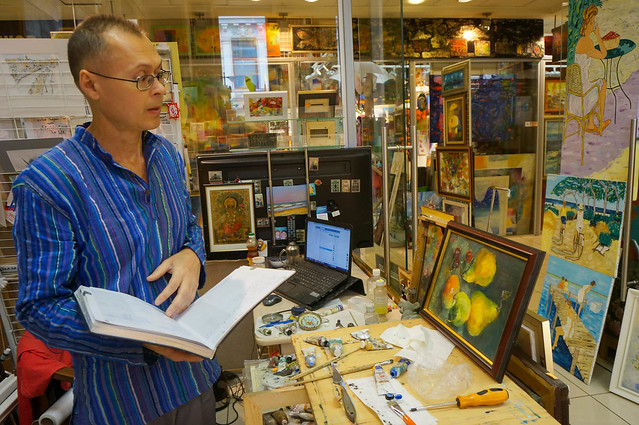
As he stuffs the small painting in a plastic bag, he tells me he would like to visit the States someday. Maybe San Francisco. In that meditative-Buddhist way, he talks softly about how people sometimes encounter each other again. I smile -- in that case, you should know that my name is Nina.
Ah, Nina! The name of my first true love!
It is, after all, a very common Russian name.
We shake hands. I leave.
I'm on Nevsky Prospect again. A few beautiful sights as I walk along:
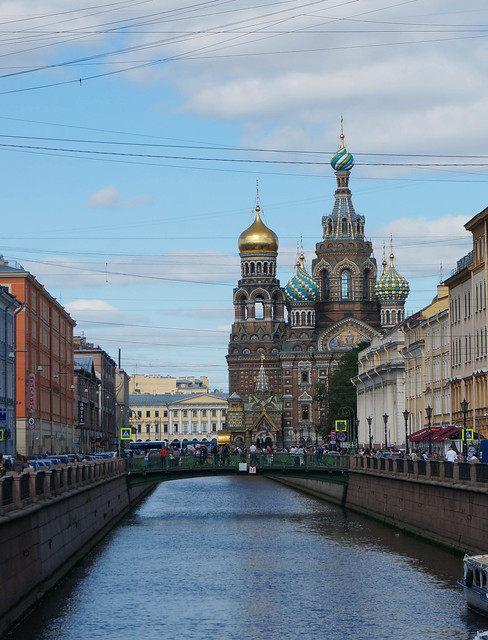
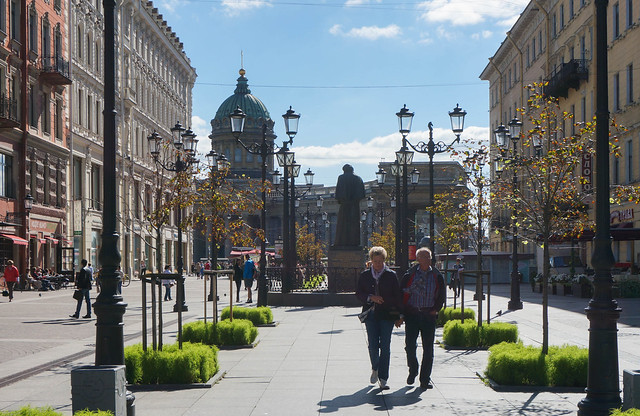
(a monument commemorating Gogol behind the sweetly affectionate older couple)
I pause just twice more -- at a tea shop, where the clerk again gives me that beautiful, Monalisa smile (I buy a chocolate bar for late night munching), and at a major souvenir shop which I dislike for its enormity and price level and so I leave almost instantly.
And now is the time for my visit to the great Hermitage -- the museum that brings so many to St. Petersburg.
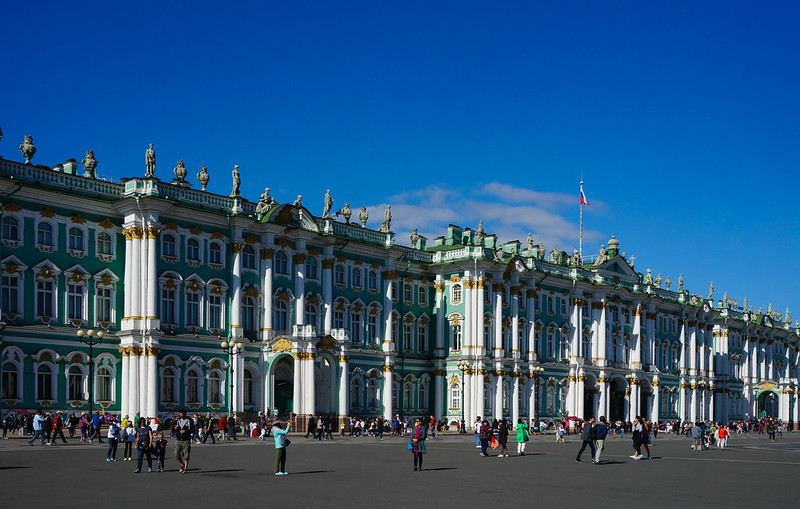
My friends and I had talked about how to strategically avoid the crowds. But the truth is, there isn't a one great time. It's always crowded. Especially in August when so many vacationing families come here. You can do yourself the favor of getting tickets online and we did that even back in the States. After that, if you want to see the best of the best, you're just going to have to be patient with the crowds. Out of 360 rooms full of art, it's a major challenge just to navigate the place, which is why I encounter more people moving through with tour groups (with buses and cruise ships waiting outside to suck them right out of here immediately after) than in any other museum ever!
You can take photos...
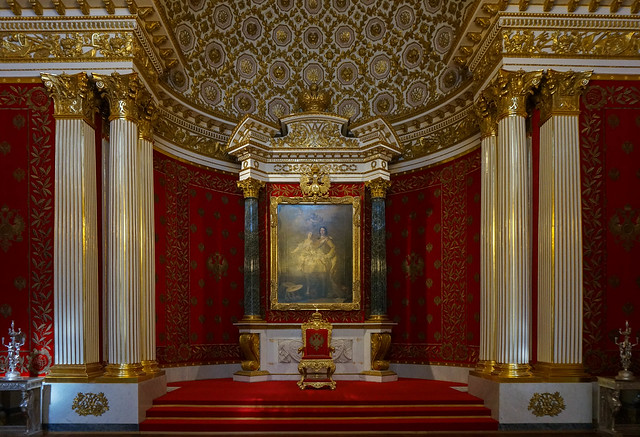
(here's the throne of Peter the Great)
...and I did, some, but not too many. For the most part, everyone moves along in a very polite and cheerful manner. They make room for those who are bent on taking a quiet photo and take turns without fuss or complaint.

(mother and daughter before the newly reopened Great Church)
And so it is mildly amusing (and greatly annoying) that my one encounter with nastiness came from the one time I heard the English language. I was heading toward the door to a room and as always, in tight spaces, we all merged just a little too closely together. I must have pressed a notch too hard against the frame of a woman because she said in a loud voice that I can only describe as pure New York -- excuse you!!
I almost retorted, but it struck me as sadly ironic that the only unpleasant exchange in the room (perhaps in the entire 360 rooms) would be loud and between two Americans. And so I stepped back as best as I could to let her pass.
One of the most crowded rooms was without question, the one containing the two Leonardo's. It was so densely packed, that an oversees visitor, not wanting to wait his turn to get close to the painting, merely stuck out his phone camera to take the picture, only to examine it after, on his screen. I found this to be quite funny and indicative of the popularity of The Great Artists. I only got close to one of the Leonardo's -- but I passed on taking a photo.
The other crowded room was with Rembrandts. Honestly, the great museum in Amsterdam had perhaps three times as many Rembradts and one hundredth the number of visitors, but the fact is, the Hermitage has it all -- from antiquity to the present. And so if you have to see one museum of art in your life, it would not surprise me if you picked only this one.
Here's a Rembrandt canvas that did not draw crowds, even though I liked it quite a lot.
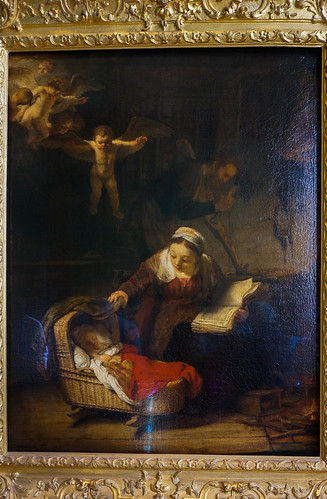
Just two more photos from the Hermitage -- both from the Italian room...
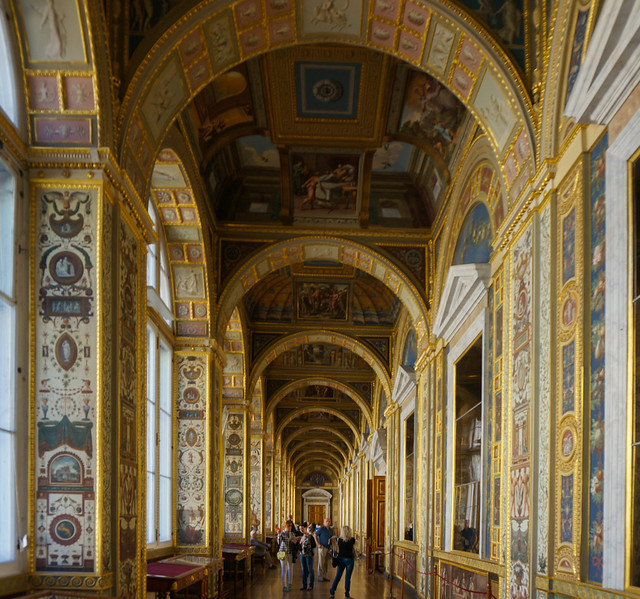
...where I got into trouble with the guard (it was entirely justified) because I leaned against the wall to take this selfie.
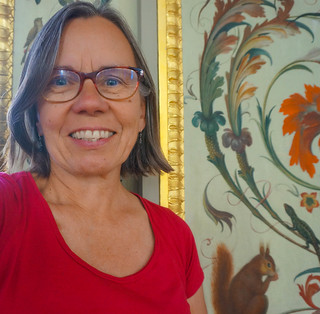
On Wednesday, we'll be back at the Hermitage, in its newly opened General Staff section. More on that when the time comes.
It's nearly 5:30 by the time I leave. Near the exit, there is an "internet" room, where some visitors are looking back at art on a handful of computer screens.
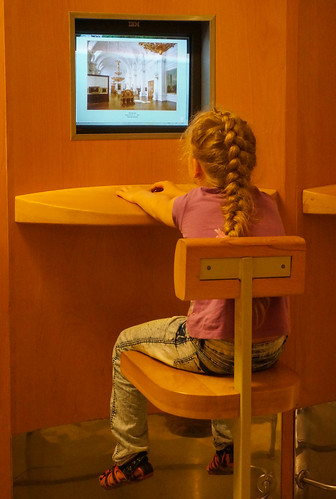
I imagine this young girl is thinking: why suffer the crowds when I can see the same stuff here?
Why indeed! Perhaps because you get to appreciate not only the art, but people's love of great talent. More than three million people visited the Hermitage museum last year alone. That says something about us. It's a great statement about our common humanity, I think.
It's 5:30 and I am out, walking in the brilliant sunshine which at this time of the day feels at once burning hot when you step in it and disconcertingly cool when you hit a shady block. I pass the Church on the Spilled Blood and I think -- why not go inside now! (Officially it's the Russian Orthodox Church of the Resurrection of Christ; it's colloquial name refers to the attempted assassination of the reformist tsar -- Tsar Alexander II -- in 1881)

There are no lines now at the ticket booth. And the light is beautiful!
Honestly, I think it's one of the most dazzling church interiors I have ever seen. Imagine: every surface covered with mosaics! 7000 square meters of them!
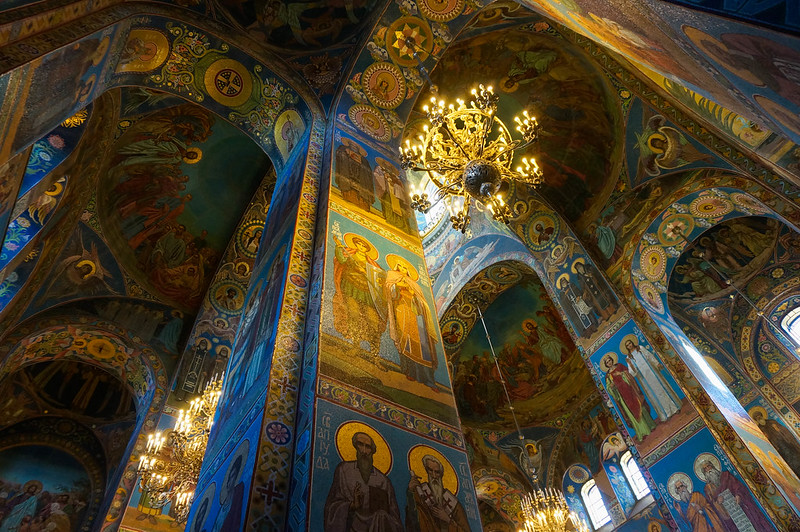
It takes your breath away! There is crowd control during the day, but now, in the near evening, the crowds are thinning. And besides, no one is ever in your way -- you just have to look up!
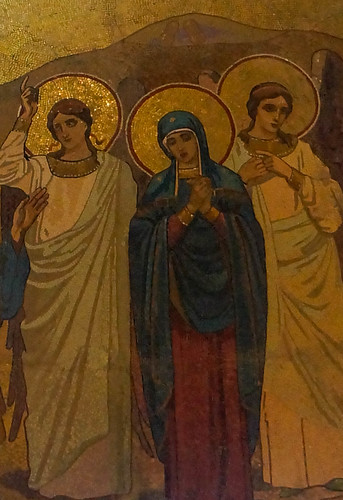
I'm outside again. I watch the tourist streams disperse. An occasional visitor will still pause at the souvenir stalls, but the historic center of the city is quickly emptying.
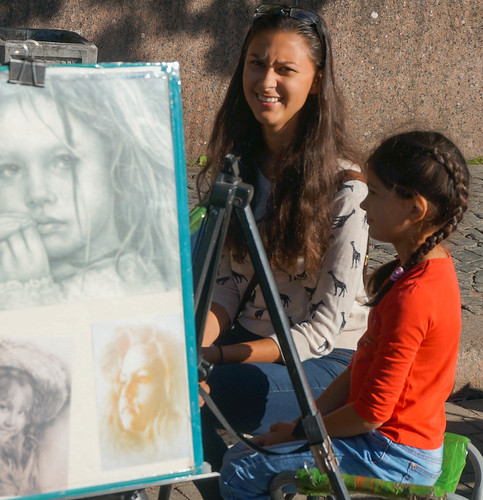
(a mother smiling at the sketch of her daughter)
I cross the canal to my even quieter neighborhood. Now is the time to pause for a cup of tea and there is no better place for this than Bize. The one on Mokhovaya Street. It's a cafe-bakery just a couple of blocks away from my hotel.
Oh, what a lovely place this is!
"Bize" are those meringue cookies that go into a Pavlova or a macaron. I have a tea with a macaron and I am in heaven.

I also purchase a pack of fruit jellies. Over the years, I've lost my great love for sweet things, but my heart and my taste buds always make room for good meringue (with just that touch of softness inside) and for fruit jellies (made from real fruits).
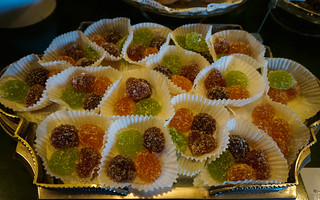
Next door to the cafe, there is a clothing store that strikes me as being a touch more modern. I go inside. The racks have a few items that are made in Korea, but they also have a few cotton frocks that are made here in St Petersburg.
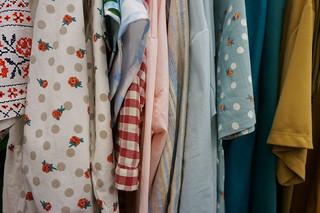
The lovely and extremely friendly clerk explains that the store's owner sews them. I am enchanted (though not enough to make a purchase -- I just do not need more clothes). This is the modern face of Russia that transcends all the stuff you read about. I see such stores popping up in Poland all the time now -- creative, energetic, with a sense of unique design -- and I am happy to see this here as well.
My two friends and I head out for dinner in the late evening. We go to another place that is new, creative, modern. It's called Schengen and I wonder if this is a reference to the abolishing of border control in most European countries (several countries that are not EU members nonetheless have signed the Schengen agreement). The young staff is exceptionally eager to please and we have a wonderful meal. Fish, salads, dessert -- all of it tasty, all of it artfully prepared.

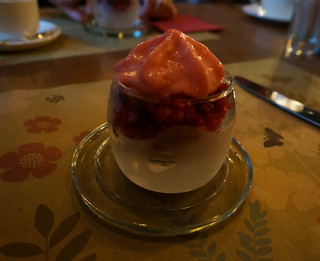
And now it's time to go home for the day. Wherever your home may be.



I'm loving all the braids on the girls. And it seems every child loves matruska dolls at some point. Beautiful photos is an understatement.
ReplyDeletePhew, it is really difficult keeping up with you, Nina. This grandmother-gig has put rockets in your pockets. But finally I am up to date. The Hermitage stuff was great, and I agree with you on the preferred Rembrandt. But, the best image here is the photo of the two women at their vegetable stand. Stoicism, great beauty and humor in the faces and pure temptation in the vegetables. (Especially the mountains of shredded cabbage -?- topped with carrots, I think.) I am curious about your keeping in touch with your occasional companion friends. Could you not, at Ekatarina, for example, just call them? Loving these posts. Cool here today in your neighborhood after very very heavy rain yesterday.
ReplyDeleteI've enjoyed sharing Ocean with my mom as I've been visiting (still trying to talk her into getting an iPad - the world at her fingertips)
ReplyDeleteThe cathedrals and all of the gilt interiors are beautiful, but I find myself scrolling through those and pausing to really look at the sidewalk scenes and the people. The wry expressions of the vegetable sellers, the old women looking so severe (gravity being a factor here), the young people on their bicycles - I enjoyed your comment that they could as well be in Russia or Warsaw or Madison. I saw a little girl with braids who looked just like Little Me :) My mother braided my hair every morning as I ate my oatmeal standing up. Soon I grumbled so pitifully that she took me have my hair cut short short short. Braids were one of those old-country styles (growing up in multi-ethnic Cleveland) from which all children seem to run away. Now, of course, life comes full circle and I think plaited hair is beautiful.
I didn't understand what you were talking about, and a commenter agreed with you, about lack of "pride of place" here at home? You must go different places and know different people. I'm of the generation that was raised with great pride in our country, and my hardworking parents tried to take us to experience vast differences and breathtaking beauty from coast to coast. We were raised with hometown loyalty ("be true to your school") and close neighborhoods with block parties.
My husband and I raised our own boys much the same way, with full hearts. Now they too seem to feel such pride in the city where they live, happy to show us around and share it with us. Busy happy polite friendly crowds everywhere (the exception is so rare) - don't you think they feel pride and loyalty to the place they call home?
Unless I misunderstood you completely.
JoyD -- You did misunderstand. I blame myself: I'm writing opaquely. Let me explain. Here's the snippet you're referring to:
Delete"So many of my own countrymen and women (and remember, I am a citizen of two countries: I speak for both) do not look this way with respect or admiration." Meaning they do not look at Russia with respect or admiration. "This must surely weigh heavy on a national psyche!" Meaning the Russian national psyche. "There is, after all, so much to be proud of." Meaning there is so much in Russia to be proud of. "Even as the discussion elsewhere quickly becomes political." Meaning, when you talk about Russians in the US (or Poland), the discussion quickly becomes about the politics of the place.
And no, I don't think the Russian people appreciate the way they are characterized elsewhere. It reminds me of Poland at a time when the politics of my country were scorned by the west. Poles suffered terribly and looked inwardly (with unfortunately not a small amount of national pride which verged on nationalism) to overcome the feeling of smallness. Other countries (let me not point fingers now!) made us (Poles) feel small. We knew better, but we felt the pain of the dismissive characterizations.
Do you see the similarities with Russia now? These are hard things to explain to an American. Americans were never made to feel small. It's not a good feeling. I'll write more about it in my post from Wednesday.
I love the final picture -- that quintessentially Eastern European (assuming here -- others likely do it too) way of splitting the load between two. The watermelon is much more pleasant sight than the duffle bags I got used to seeing in Poland.
DeleteThanks, Nina... and thanks to JoyD for drawing this out of you! As my daughter says to me "You were raised during the Cold War, so you don't see Russia as I do." And from what she's said and now from what I see here, I can see she's right and you're right. (By the way... as Snowdrop's aunt, she'll be delighted to hear you got S a genuine Russian matryoshka... she's always loved them!)
DeleteI see now, Nina. "This way" threw me. Such a small phrase, to turn me all the way round.
ReplyDeleteI look forward to tomorrow on Ocean.
I think it was an eye-opener for me, moving outside of the U.S., to really understand-- "Oh, America is not the center of the universe... except when you're in America... there's a lot going on in the world and it doesn't necessarily have to come from the U.S. perspective." And then going back for a few months this spring/summer and feeling many times that Americans don't really care that much about the, in this case Danish perspective/way of doing things. In both places, there seems to be a big sector of the population that doesn't express curiosity about the other (though there are, of course, exceptions in people from both countries), or perhaps there is a curiosity but a timidness about asking? I'm not sure...
ReplyDeleteI would agree that all countries think they have it figured out (about other countries). My Polish friends rarely ask me about America, but they are happy to listen to any and all stories that I tell them. My American friends (with exceptions, and I am traveling with one such exception!) never ask about Poland and have patience for only the most superficial reflections. And mind you, there is a lot of America present everywhere in Europe, through pop culture, music, food. But what do Americans know about Poles or Russians? Or Danes?
DeleteBut I think the explanation for this is complicated. Maybe timidness, maybe that people do not have enough of a context. Where do you begin when you know absolutely nothing? Too, there is much less movement, less crossing of borders, less language learning (Russians, for all their insular habits these days, learn two languages in school, early on) -- all this dampens curiosity. You tends to be curious about things that cross your path. Few Russians or Poles (except for immigrants and that's a whole 'nother story) cross the path of an average Joe or Joanna.